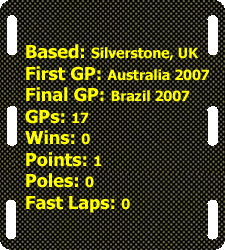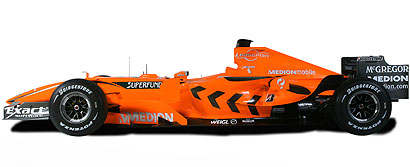|
On September 9, the weekend of the Italian Grand Prix, following weeks of speculation, The Midland Group of Companies, owner of Midland F1 Racing, announced the sale of the team to Spyker Cars NV, the Dutch high performance car manufacturer.
At the same time, Spyker announced that it has acquired the services of Mike Gascoyne as Chief Technology Officer, and would be retaining Colin Kolles as Team Principal.
A few weeks later, the Dutch team, having already announced a number of new sponsors, revealed that it had concluded a deal with Ferrari whereby it would run the Italian outfit's V8s in 2007.
Having revealed that Christian Albers was to continue with the team it was widely thought that the Dutch outfit might choose to retain Tiago Monteiro, however, much to the surprise of many, not least the Portuguese driver, Germany's Adrian Sutil was recruited.
Over the Winter, the team announced a raft of sponsorship deals including Trust, Philoderm, the McGregor Fashion Group, Medion AG and Exact Holding N.V, a software company.
Furthermore, on February 1, just days ahead of the launch of its first car, the team named no less than four test and reserve drivers, including Giedo van der Garde, who was already under contract to Super Aguri.
Despite the obvious promise, Ferrari power-plants and Mike Gascoyne, not to mention Adrian Sutil, there was talk from the very outset of the season that Spyker, like its predecessors, had money problems.
While Pitpass' Mike Lawrence openly questioned why an exclusive Dutch sports car manufacturer felt the need to be in F1, Gascoyne made it clear that without investment the team couldn't move forward. That said, despite its limited budget, the team posted a number of good performances, embarrassing teams with far more in the coffers.
With money limited, Gascoyne struck a deal with Aerolab which allowed the team precious windtunnel time as it sought to improve on James Key's original design.
The team suffered a serious setback when its B-spec car failed the mandatory rear impact test, meaning that the upgraded car didn't appear until Monza.
Some clever strategy, particularly with regards tyres, and strong driver performances, usually from Sutil, meant Spyker often out-performed its better funded rivals, however, the highlight of the season had to be the European GP at the Nurburgring. Markus Winkelhock, making his F1 race debut, was brought in at the end of the parade lap and fitted with wet-weather tyres, the German going on to lead the race for a brief, but glorious, few laps.
Albers never caught the imagination, and a number of needless errors, including clashes with his teammate, led to the Dutchman being dropped after the British GP.
While Winkelhock impress on his F1 debut, Sakon Yamamoto was recruited for the remainder of the season. Once he'd found his feet, the Japanese driver actually began to give Sutil a run for his money.
Sutil regularly impressed, and though erratic on occasion, he delivered a number of impressive performances, most notably in Saturday free practice at Monaco, and his point-scoring finish in the rain at Fuji.
Throughout all this, speculation regarding the future of the Dutch team continued, with Indian billionaire Vijay Mallya and A1 GP boss Tony Teixeira both linked with the inevitable consortium buy-out.
In mid-August, the team issued a statement denying that its future was in doubt, stating: "Spyker F1 Team Ltd is completely confident that it has the necessary budget to race in the FIA Formula One World Championship this season."
Nonetheless, the speculation continued, and in mid-October it was revealed that Mallya, along with Michiel Mol, had bought the team, which would race in 2008 as Force India.
And so, the third incarnation of Jordan was finally put to rest, having scored one point from its 17 race career.
|


























